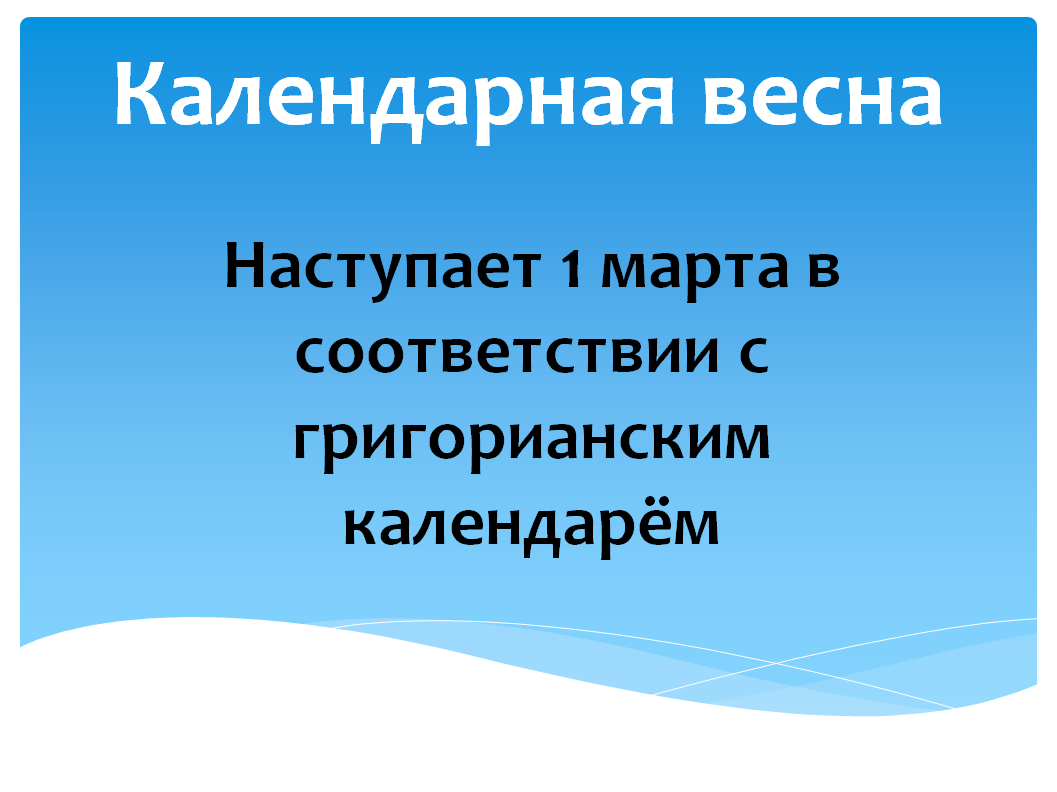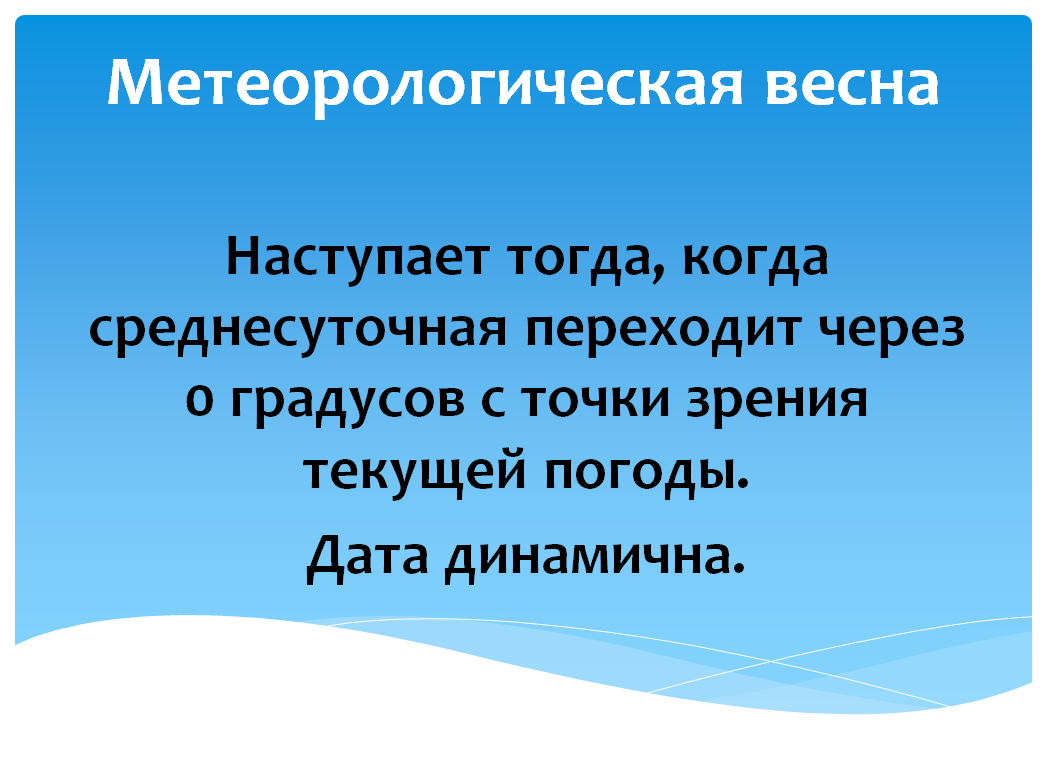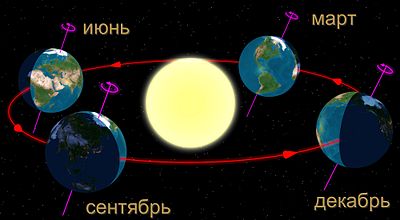The beginning of spring and not. Astronomical spring, or vernal equinox
Spring begins immediately after winter and ends with the arrival of summer. But determining what date spring begins is not at all easy. The fact is that different areas of knowledge use their own definition of spring. Calendar spring – this is a transition period. At this time, daylight hours increase, air temperature rises, living beings and plants become more active. Calendar spring consists of 3 months. March, April, May are the spring months of the Northern Hemisphere. In the South, spring begins in September and ends in November. IN real life spring does not obey it and comes earlier in the southern regions, and late in the northern ones. Astronomical spring term coined by astronomers. It comes into its own on the day when spring begins according to the Sun. It arrives in the Northern Hemisphere on March 20 (21), on opposite side On Earth, this unique phenomenon is observed on September 22 (23). Astronomical spring ends on the day summer solstice. Climate spring occurs when the average daily temperature consistently exceeds 0 degrees. IN Vologda region The transition of the average daily temperature through 0 degrees occurs in the first ten days of April. The beginning phenological spring The period of snow melting (formation of thawed patches in the field) is considered. Spring ends with the onset of summer, which is determined by the flowering of rose hips. The cultural characteristics of the peoples of the world determine their timing of the arrival of spring. Since ancient times, Rus' has celebrated the day of welcoming spring on March 22. His name was "Magpies". There was a belief that forty birds fly to Magpies, the magpie builds a nest and comes real spring. In addition, Maslenitsa is widely celebrated in Rus', a holiday of farewell to winter, which was later connected with church calendar and marks the beginning of Lent.
In Romania and Moldova, on March 1 it is customary to celebrate Martisor (the holiday of welcoming spring). In honor of the holiday, it is customary to give each other small boutonnieres in the shape of flowers, which are worn on clothes all month, and on March 31, they are removed and hung on trees. The holiday is born a beautiful legend about the victory of spring over winter: on the first day of March, the beautiful Spring came out to the edge of the forest and saw a snowdrop emerging from under the snow in the thickets of thorns. She decided to help him and began to clear the ground around him, freeing him from the thorny branches. Winter saw this and became furious. Waving her hands, she called cold wind with snow to destroy the primrose. The weak flower wilted under the cruel wind. But spring covered the sprout with its hands and pricked itself with a thorn. A drop of hot blood fell from her wounded hand, and the flower came to life. In Germany they celebrate the beginning of spring in April, Americans begin to prepare for its arrival in advance on February 2, Groundhog Day. People believe the predictions of marmots and believe that they can announce the approach of spring. Groundhog Day has its ancestors: even the ancient Romans “consulted” with animals, celebrating Hedgehog Day on February 2. In France there is an unusual holiday, although it is partly similar to our March 8th - Grandmothers' Day. On this day, only women aged 55 years and older receive congratulations. The heroes of the occasion slowly stroll through the streets of the city, announcing the arrival of spring. In Japan, from the first of March until the end of April, Hanami is celebrated - a holiday of admiring sakura. Across Japan, hundreds of trees are covered in pale pink flowers. Holi, or the festival of colors, is celebrated annually in India. dedicated to god love Kamadeva. It is also called the Bengali New Year and this event marks the arrival of spring. This year, the calendar spring in the Vologda region will be marked by a thaw: Atlantic cyclones together with precipitation will bring warming, daytime temperatures will again be above zero. It is too early to consider this the arrival of spring, since in the future there will be more than one return of cold weather.
Materials used to prepare the article: http://nimffa.ru, photo: https://www.look.
.
Forecaster of the OGMO department Rykovanova O.I.
And it's spring- not real!
When does spring actually begin in Russia? Myths about spring
The first misconception concerns the date of the beginning of spring. Of course, most firmly believe that spring comes on March 1st. Tell the residents of Chukotka and Oymyakon about this. In Anadyr at this time, daytime temperatures fluctuate around -20...-25, and this is the norm for March 1, and in Oymyakon around -35...-40. And where is spring then? And there’s still at least a month before it, and in Siberia it’s only two!

There is such a thing as calendar, climatic, meteorological and astronomical spring. Oh, how! So it is precisely the calendar spring that begins throughout the northern hemisphere on March 1, and it has nothing to do with the weather, birds and streams. What exactly is spring?
Spring is the process of nature awakening after hibernation. And the launch of these processes is directly related to one key indicator - temperature.
March- spring month?
Another misconception concerns the first spring month- March. It has never been spring, March is still winter month. On larger territory Russia it average temperature below zero. The rivers are covered with ice snow cover has not yet descended, frequent Arctic incursions occur, accompanied by intense snowfalls. March is a winter month. It is spring only from the point of view of the calendar.
When did it start?
If March 1 cannot be taken as the date of the beginning of spring, then when does it begin? Each region has its own date and depends on the climate. There is a so-called climatic and meteorological spring. How are they different?
Climate spring

It should immediately be noted that the start date of climate spring is static. It does not depend on the weather outside the window, but depends on the weather that has happened over the past 30 years. It is this period of time that climatologists use to describe climate. Climatic spring occurs when the average daily temperature exceeds 0 degrees in positive side. As a rule, this is the average date, after which the snow rapidly melts, the opening of rivers begins, and vegetation processes begin. Nature comes to life. Real spring is coming! In Moscow, for example, the start date of climate spring falls on March 20, and in Yakutsk on April 27. The difference is obvious!
But in some cases, winter is delayed and spring does not come even after the start date of climatic spring.
Meteorological spring

The onset of this spring is directly related to the thermometer readings. Therefore, the date of the onset of meteorological spring is dynamic, and each year falls on different dates. Meteorological spring occurs when the average daily temperature exceeds zero and remains stable for five or more days. For example, in 2015 in Moscow, meteorological spring began on February 20! Of course, in this case, the meteorological spring came earlier than the climatic spring, so it can be considered early.
Astronomical spring

Everything is even simpler here, as is obvious from the name. Astronomical spring comes on the day spring equinox and most often this date falls on March 20th. March 20 is the day of the onset of astronomical spring. At this time, the Earth is in a position relative to the Sun when both hemispheres, from the equator to the poles, heat up relatively equally. This happens twice a year: March 20 - on the day of the vernal equinox and September 23 - on the day autumn equinox.
From March 20, the seasons change across the hemispheres; astronomical autumn begins in the Southern Hemisphere of the Earth, and astronomical spring begins in the Northern Hemisphere, which continues until the summer solstice (June 21). After the day of the vernal equinox, spring warmth always comes, no matter how cold it was before.
Bottom line
The question arises: which spring date should be taken as a standard, so as not to make a mistake? This is a climatic spring, the date of which depends on the climate of the region. Below is an indicative table for different cities in Russia.

Average timing of the onset of climatic spring in different cities Russia
When spring comes in St. Petersburg, Novosibirsk, Yekaterinburg, Nizhny Novgorod, Kazan,
Chelyabinsk, Omsk, Samara, Ufa, Rostov-on-Don, Krasnoyarsk, Perm, Oymyakon, Tiksi, Khabarovsk, Vladivostok, Magadan, Murmansk, Salekhard, Kurgan, Tyumen, Khatanga. When does spring come?
March 21 is the day of the onset of astronomical spring, it is also called the day of the vernal equinox. At this time, the Earth is in a position relative to the Sun when both hemispheres, from the equator to the poles, heat up relatively equally. This happens twice a year: March 21 - on the day of the vernal equinox and September 23 - on the day of the autumn equinox.
From March 21, the seasons change across the hemispheres; astronomical autumn begins in the Southern Hemisphere of the Earth, and astronomical spring begins in the Northern Hemisphere, which continues until the summer solstice (June 21). After the day of the vernal equinox, spring warmth always comes, no matter how cold it was before.
The ancient scientists of China, India, and Egypt knew very well about the days of the vernal equinox. In ancient times, the days of the vernal equinox were considered big holiday. Nature is being reborn again, bears are waking up, animals are beginning to live more active image life, preparing for procreation.
In religion in old times The day of the vernal equinox was also given no small importance. The date of Easter, which is celebrated every year on different time, was counted from the day of the vernal equinox as follows: March 21 - the first new moon - the first Sunday, which was considered a holiday.
It all started in 325 AD, when the Council of Nicaea took place, at which the Julian calendar was adopted for everything Christendom. According to the resolution of the Council of Nicaea, the equinox had to fall “forever” on March 21, as it was in the year of the council, but at the end of the 14th century. Christian church suddenly discovered that the spring equinox no longer coincides with March 21, and moreover, every 128 years it comes one more day earlier, and when the error was noticed, the difference was already 10 days: according to Julian calendar The moment of the equinox was supposed to occur on March 21, but in reality it occurred already on March 11. Many astronomers pointed out this, and the churchmen more than once intended to carry out the reform, but each time it was postponed due to various reasons. Finally, Pope Gregory XIII announced a competition for best project new calendar. The winner was the project of the Italian mathematician Lilio. And in 1582, the pope issued a special bull, according to which the count of days was moved forward by 10 days and the Friday after Thursday, October 4, 1582, was ordered to be counted not as October 5, but as October 15. This immediately corrected the error that had accumulated since the Council of Nicaea, and the spring equinox again fell on March 21.
Many peoples have preserved the day of the vernal equinox as a holiday in the calendar. For example, in Farsi it is called Nowruz, which means “new day.” Rooted in the traditions of the ancient farmers of the Middle East and Central Asia, the holiday has become an integral part of the culture of many peoples who profess Islam. In the CIS it is celebrated as a national one by Tatars, Kazakhs, Bashkirs, Kyrgyz, Tajiks, Uzbeks and many other peoples. Navruz has been announced in a number of countries public holiday, and March 21 is a day off. In Japan, the day of the spring equinox is celebrated - Shumbun no hi. The weekly period starting three days before the spring equinox is called Higan. At this time, the Japanese visit the graves of their ancestors, and sakura blooms in the gardens.
In Russia, they are most happy that the daylight hours will increase every minute and the long-awaited summer will come.
What day do you consider the first day of spring? What are the first days of summer, autumn and winter like for you?
Seasons are four periods into which the annual cycle is conventionally divided. The change of seasons is determined by the annual period of revolution of the planet around the Sun and the inclination of the Earth's rotation axis relative to the orbital plane and, to a small extent, the ellipticity of the orbit.
There are:
Calendar seasons- in most countries of the world it is customary to divide the year into four seasons, three calendar months in everyone.
Astronomical seasons, which are counted from the points of the solstice (summer, winter) and equinox (spring, autumn).
Phenological seasons. Phenology determines the duration and timing of the beginning of each climatic season in accordance with natural phenomena(using the concept of season). Each season has its own characteristic weather and temperature conditions.
In mid-latitudes, a formal, calendar division of the year into four approximately equal periods is often used.
For example, in most countries in the northern hemisphere the following start and end dates for the seasons are accepted:
IN southern hemisphere The following dates are accepted:
Govrie is a rationalist by nature, tends to trust more exact sciences, and within the framework of this issue - astronomy, in particular. It would seem that there is nothing difficult here, divide the calendar into 4 equal parts - here you go exact dates the beginning and end of the seasons!.. But that was not the case!
From point of view official science, astronomically, the seasons are separated by the moments of the summer solstice, autumn equinox, winter solstice and the spring equinox.
The beginning of the astronomical seasons is taken to be the moments when the center of the Sun passes through the equinoxes and solstices. That is, from an astronomical point of view, spring does not begin on March 1st.
Astronomical spring– this is the period from the spring equinox (March 21) to the summer solstice (June 21). Its duration is approximately 92 days 20 hours and 12 minutes.
Astronomical summer– this is the period from the summer solstice (June 21) to the autumn equinox (September 23). Its duration is approximately 93 days 14 hours and 24 minutes.
Astronomical autumn lasts from the autumnal equinox (September 23) to the winter solstice (December 22) for 89 days, 18 hours and 42 minutes.
Astronomical winter lasts for approximately 89 days and 30 minutes - from the winter solstice (December 22) to the spring equinox (March 21).

"And what's the catch?" - you ask.
With spring and autumn, astronomers decided very convincingly and elegantly. There is no arguing here, it is true - spring begins from the day from which the duration of daylight hours begins to increase, and autumn - on the contrary, from the day when the duration of daylight hours begins to decrease.
But the catch is that winter even in the most European of Europe and asian asia cannot begin on December 22, and summer cannot begin on June 21. December 1 as the conditional beginning of winter and June 1 as the beginning of summer - this is all right, but June 21 and December 22, according to Govrie, cannot be considered the first days of these seasons.
Then what - according to the phenological theory, every year the first day of spring, summer, autumn and winter should be considered different dates, depending on the average daily air temperature achieved? Somehow, not humanly.
And this comes in very handy folk traditions and customs.
In Russian Orthodox culture is considered the first day of summer Nikolin's day, May 22, and the first day of winter is recognized Pokrov day, October 14.
In fact, both of these dates are Orthodox holidays, the first of which is associated with the veneration of St. Nicholas the Wonderworker, subsequently popularized in Western culture in the person of Christmas Santa Claus, and the second with the veneration Mother of God, Mother of God.
May 22 is popularly known as St. Nicholas Day and is considered an important agricultural date. On Nikola Veshny, the grass becomes lush and tall. Horses and cattle were driven out to green pastures. “May the horse fatten up.” From Nikola begins the mass planting of the main food in peasant houses - potatoes. Blueberries, wild strawberries, forget-me-nots and swimmers are blooming. Mosquitoes appear from Nikola and summer begins.
In Rus', the holiday of the Intercession has long been associated with the beginning of winter and the sayings were dedicated to it: “On Intercession the earth is covered with snow and covered with frost”, “On Intercession it is autumn before lunch, and after lunch it is winter-winter.”
Govrie decided for himself this way: spring will begin on March 21, summer on May 22, autumn on September 21, and winter on October 14.
And for you, on what days do spring, summer, autumn and winter begin?
